“Down the chain you’re finding paralegals and assistants spending hours and hours per day to get basic information about patent applications,” said Chad Gilles of BigPatentData. “Due diligence can now be a four-hour project because Public PAIR is so overloaded.”

Jamie Holcombe, USPTO Chief Information Officer
Jamie Holcombe, Chief Information Officer at the U.S. Patent and Trademark Office (USPTO), seemed surprised to learn on Wednesday that both the Public and Private versions of the USPTO’s Patent Application Information Retrieval (PAIR) System have serious issues that are making workflows untenable for users.
Holcombe was participating in a public Forum on the PAIR system, where USPTO staff listened to stakeholders’ experiences since the Office implemented major security changes to the system on November 15, 2019. “The USPTO disabled the ability to look up public cases outside of a customer number using Private PAIR,” explained Shawn Lillemo, Software Product Manager at Harrity LLP, who attended the Forum. “Most patent professionals prior to the change could retrieve all the PAIR information they needed from Private PAIR. That is no longer true.”
Now, in order to retrieve applications associated with a different customer number, users must open Public PAIR. “This means that if you are looking for applications cited in an office action, you can no longer retrieve them from within private PAIR,” Lillemo added.
“More significantly, if you counsel for a client that maintains its own customer numbers in order to directly receive correspondence, attorneys do not have access to the file history in Private PAIR and must try to retrieve the information from Public PAIR. The usability of Public PAIR exacerbates this problem.”
Furthermore, many docketing and other IP software systems had developed interfaces to Private PAIR as a work-around for the lack of a PAIR application program interface (API), explained Lillemo. “The changes made by the USPTO broke many of these automated connections. Attorneys and staff were suddenly required to manually perform tasks that had previously been automated.”
Lillemo provided IPWatchdog the following synopsis of the current sticking points with the two systems:
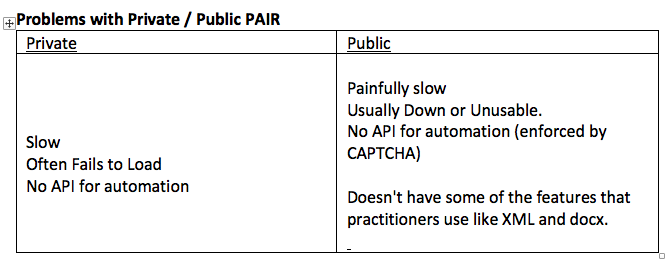
“It’s Broken”
The USPTO said in November that the changes were intended to “remove the ability for Private PAIR users to mine data belonging to others in Private PAIR—that is, to run automated scripts (bots) that query data not associated with that individual user account and its associated customer number(s).”
But attendees of Wednesday’s Forum explained that there are many reasons practitioners may need information not associated with their customer number.
“There needs to be a way for registered practitioners to use Private PAIR to get [information] they’re not associated with because there are a lot of legitimate reasons why you’re looking up applications that are not under your customer number – this is way too restrictive and it’s adding way too much time to people’s workflows,” said one attendee.
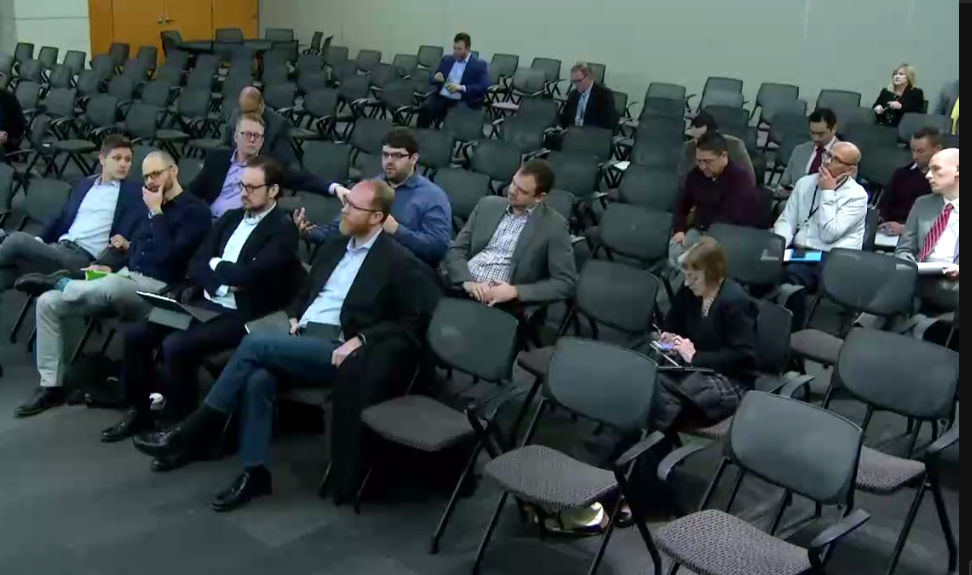 For example, in the case of clients with a relatively complex patent family as the result of a spin-out or merger where the patent family crosses multiple organizations, no one organization has access to the information on Private PAIR anymore, said Drew Winship of patent analytics firm Juristat, which boasts 25% of the top 100 law firms as clients. “How do you get access to it? It’s literally impossible now.” Short of gaming the system, which Winship said the company won’t and doesn’t want to do, “we just have to stop providing the service, which law firms and assignees clearly want.”
For example, in the case of clients with a relatively complex patent family as the result of a spin-out or merger where the patent family crosses multiple organizations, no one organization has access to the information on Private PAIR anymore, said Drew Winship of patent analytics firm Juristat, which boasts 25% of the top 100 law firms as clients. “How do you get access to it? It’s literally impossible now.” Short of gaming the system, which Winship said the company won’t and doesn’t want to do, “we just have to stop providing the service, which law firms and assignees clearly want.”
The Forum participants said that the changes are affecting small firm patent practitioners, paralegals/ law firm support staff, and service providers/ vendors most.
“Down the chain you’re finding paralegals and assistants spending hours and hours per day to get basic information about patent applications, said Chad Gilles of BigPatentData on Wednesday.“Due diligence can now be a four-hour project because Public PAIR is so overloaded.”
Courtenay Brinckerhoff, a partner at Foley & Lardner and Vice Chair of the Intellectual Property Owners Association’s Patent Office Practice Committee, added that Private PAIR is also problematic. “To the extent the separation [between Public and Private PAIR] was supposed to help Private PAIR, it’s broken,” she said. “I’m having better luck getting into Public PAIR to check a case, but I can’t get everything [I need].”
Brinckerhoff added that such hindrances are particularly problematic in the case of portfolio transfers, for instance. “The first thing our transfer team does is go on to PAIR to verify the status and get an update; that’s significantly handicapped by this change. It’s time sensitive.”
Winship called the USPTO’s approach “overly Draconian” and said that the problems are also causing the quality of Information Disclosure Statements (IDS) to plummet. Other attendees pointed out that the risk of not filling out an IDS correctly due to inaccurate or out-of-date information is significant. “You’re not complying with the duty of candor to the PTO,” explained one participant, which can lead to patent invalidation and/or being disbarred by the USPTO’s Office of Enrollment and Discipline.
Lillemo found it especially surprising that Holcombe was unaware of the issues with Private PAIR. “A quick Twitter search would reveal people that are frustrated enough to complain publicly and post screenshots,” said Lillemo.
Indeed, such tweets abound:
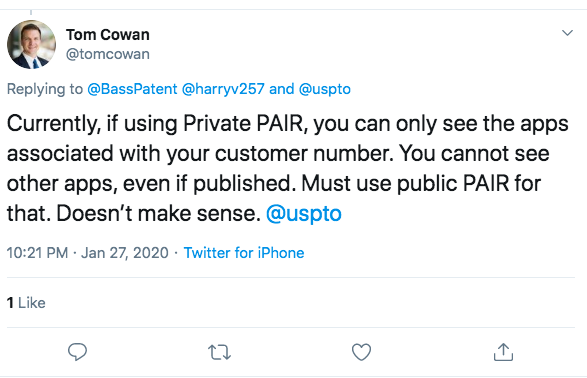

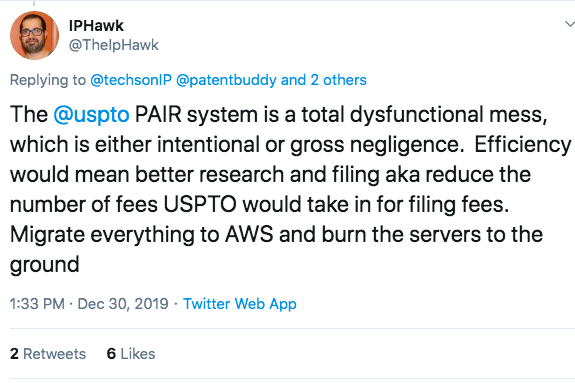
Solutions
Following the November announcement, many users complained to the USPTO and a stakeholder event was held by director Damian Porcari of the Detroit Office of the USPTO. At that meeting, many companies expressed their frustration at both the reliability of the PAIR system as well as the newly imposed restrictions, according to Lillemo.
“Representatives from the USPTO cited ‘scraping’ behavior as placing an undue load on their internal legacy systems as the reason for trying to further restrict access to PAIR systems,” Lillemo said.
As a result, a group of people formed an Open PAIR Coalition and sent a letter to Director Iancu.
The Wednesday Forum was organized in response to that letter, which proposes the following solutions:
Immediately: Roll-back the change so that credentialed access through MyUSPTO enables the logged-in user access to file wrappers that are not associated with the user’s customer number. To reduce load on the Office infrastructure, it is recommended that only licensed users or their delegates get access via MyUSPTO. Should there be inappropriate scraping, the OED has jurisdiction over licensed practitioners and may provide clear instructions, warnings, and even issue suspensions.
Short-term Action: Provide a copy of Public PAIR file wrappers to further the stated Open Data goals to disseminate IP data. Stakeholder tools depend on this data to provide the functionality users demand. It is appreciated that a tragedy of the commons was created by the Office’s leadership in making Public PAIR freely available. Many automated processes individually gather this information to create a collective burden on Office infrastructure that causes instability. With the ease of automated data gathering today, any free interface to desired data will have stability problems. The Office is a victim of their success. Although portions of this information have been hosted by third parties for free in the past, the information is incomplete and/or difficult to access effectively.
We propose that the Office facilitate inexpensive transfer of Public PAIR data in a way that makes “free” scraping unattractive. The signatories to this Impact Statement offer to provide cloud hosting of an initial copy of Public PAIR (“snapshot”) that would enjoy regular daily updates (“deltas”). That copy can be provided very inexpensively to the stakeholders in a manner far cheaper than any automated scraping effort. The Office can provide this in any format convenient and use existing protocols and infrastructure, for example, the methods used for gathering the Office Actions Dataset and the Office Actions Rejections and Citations APIs available at developer.uspto.gov. If a hard drive or tape format or particular cloud host is preferred, the Open PAIR Coalition will support the lightest touch on PTO infrastructure and staff. In any event, the need is so great in the stakeholder community that any sort of accommodation can be figured out by the Coalition.”
Long-Term Action: Although third-party cloud hosting of PAIR data can quickly undermine any incentive to scraping Public PAIR, free dissemination of IP data is a stated policy priority of the Office. The Patent Examination Data System (PEDS) along with the Open Data Portal already provide metadata on Public PAIR to stakeholders through APIs. However, full access to the prosecution histories and richer portions of the application have not been provided by API. Additionally, PEDS and other data is not updated at the frequency required by stakeholders. The absence of this IP data has largely created this tragedy of the commons.
It is proposed to finish PEDS or provide another API to Public PAIR information with further input from the stakeholder community. Source documents, XML or other formats and metadata already in the Office systems should be provided where available (e.g., status indicators, current claims, search queries, etc.) with emphasis on more information even if the format is not perfect so that the stakeholders can leverage the pre-processing already performed using their fees. Data in this system should be updated in real time (like PAIR) so that there is not an incentive to burden the servers that host PAIR & EFS with massive numbers of redundant requests for data to get it quicker as the information is, after all, public. Arrangements can be reached with stakeholders to further reduce the burden on the active systems, such as mirroring portions of the data on a third-party host. As a result, the public would have access to not only basic patent metadata (including dates, statuses, titles, inventors, and applicants), but the rich prosecution histories (arguments in office actions, responses, ex parte appeals, etc.) and the wealth of knowledge in the separate portions (specifications, claims, drawings) of the applications themselves without needing to pull each document separately.
Several of those in attendance at Wednesday’s Forum echoed the suggestion that the PEDS system be improved, updated, and made private as one way to solve the problem. “PEDS is the great start of what I believe to be a great solution,” said one participant.
Holcombe assured the Forum attendees that he would get to work on the suggestions made Wednesday.
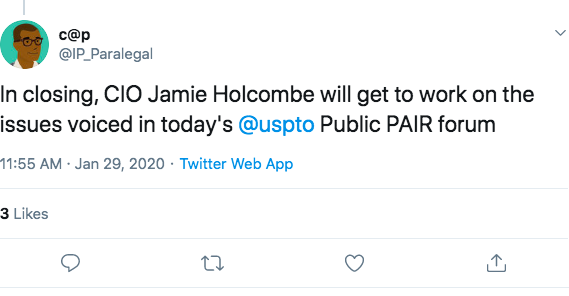
IPWatchdog reached out to the USPTO for further information on next steps, but the Office had no immediate comment.

![[IPWatchdog Logo]](https://ipwatchdog.com/wp-content/themes/IPWatchdog%20-%202023/assets/images/temp/logo-small@2x.png)

![[Advertisement]](https://ipwatchdog.com/wp-content/uploads/2024/04/UnitedLex-May-2-2024-sidebar-700x500-1.jpg)
![[Advertisement]](https://ipwatchdog.com/wp-content/uploads/2024/04/Artificial-Intelligence-2024-REPLAY-sidebar-700x500-corrected.jpg)
![[Advertisement]](https://ipwatchdog.com/wp-content/uploads/2024/04/Patent-Litigation-Masters-2024-sidebar-700x500-1.jpg)

![[Advertisement]](https://ipwatchdog.com/wp-content/uploads/2021/12/WEBINAR-336-x-280-px.png)
![[Advertisement]](https://ipwatchdog.com/wp-content/uploads/2021/12/2021-Patent-Practice-on-Demand-recorded-Feb-2021-336-x-280.jpg)
![[Advertisement]](https://ipwatchdog.com/wp-content/uploads/2021/12/Ad-4-The-Invent-Patent-System™.png)






Join the Discussion
10 comments so far.
Cathleen Rocco
May 12, 2020 10:21 pmIT is symptomatic of our failing Republic that the institution whose entire charter is to incentivise innovation instead stands in the way. I dread having to use pUBLIC PAIR – it’s fussy about formatting queries (really, would it be so hard for the software to accept all of the formats used by international IP databases, so that people wouldn’t have to waste time adding and substracting spaces, hyphens, slashes and the like?), The queries often time out or return obviously incorrect results (“the application is unavailable” when I just looked at it), and the whole thing is incredibly unwieldy – are they really still having people spend their days scanning documents?). Yet another humiliation that is the result of diverting public money away from supporting government programs that people actually really need and that benefit the republic, into the pockets of the wealthy in the form of tax breaks under the guise of “trickle down economics.” Are we through with this idiocy yet? Can we get back to the days where technical competence was a point of pride for our country?
Andy Pitchford
March 2, 2020 12:42 pmA month later…….. nothing. Everything still broken. Shocker.
E. A. Horton
February 3, 2020 03:11 pmYou can get the Image File Wrapper for US patent applications through the EPO. And it’s fast.
BP
February 3, 2020 01:53 pmExcellent post, thank you IPWatchdog.
LEAN/Agile – the USPTO needs to care about user workflows and how the USPTO can actually be a partner in driving continual improvement and elimination of waste.
That the CIO was surprised, comes at no surprise to me. Given the culture of some of the “lifers” (i.e., that bait and frustrate end user’s as if it were a game), the Office of Petitions’ inability to meaningfully address/rectify fallout from the regular outages, and the reluctance to refund fees ($$$) stemming from outages, is there any hope?
I will say that patent attorneys that do not interact with the USPTO systems directly need to listen to their staff and what they learn should be communicated to the USPTO. As a patent attorney that does interact with those systems directly, I do communicate issues to the USPTO because they impact my life, my wallet and my client relationships. Is the CIO listening?
AAA JJ
February 1, 2020 02:32 pmMaybe the PTO should stop spending money flying people all over the world to set up PPH agreements with the Seychelles Patent Office and the Antarctic Patent Office and spend it on their IT systems instead.
JMO
Peter Kramer
February 1, 2020 02:20 amIn a world where data mining is an important tool for IP analysis, I question the notion that using Private PAIR with automated tools is illegitimate or abusive simply because the PTO has not scaled Private PAIR to match information demand that has grown geometrically in the past two decades. About 8 – 10 years ago I asked the PTO how many screens could I access per day on Private PAIR. They said 10,000 per day. I only needed to do about 1500 per week, 15% of the limit. Today that’s (subjectively) consideted abusive simply because USPTO did not anticipate increasing demand. I find that to be offensive. Furthermore, mining large data sets is an activity that PEDS is designed to support, except that PEDS is as badly broken as is PAIR. If people need to use PAIR because PEDS is broken, that’s not abuse. It’s about time the PTO delivers public data to the public with operable 21st century tools rather than labeling legitimate need as illegitimate or abusive as an excuse for their IT shortsightedness.
angry dude
January 31, 2020 02:19 pmWho really cares how tombstones are arranged ?
To the morgue…
Mark Nowotarski
January 31, 2020 08:31 amI have to concur. PAIR is incredibly slow and unreliable.
AAA JJ
January 31, 2020 08:13 am“…seemed surprised to learn on Wednesday that both the Public and Private versions of the USPTO’s Patent Application Information Retrieval (PAIR) System have serious issues that are making workflows untenable for users.”
Is he surprised that it gets dark at night?
The single biggest problem with the PTO is that nobody who works there actually uses the systems they provide to users.
I remember going to a presentation on the first generation EFS system that was conducted by the PTO back in 2002 or so. There were attorneys and administrators from half a dozen firms or so there. We sat through through the presentation. At the end the PTO presenter was all smiles. Our firm’s practice administrator told her, “We would never use that.”
The PTO presenter was stunned.
Things haven’t changed much in the past 18 years.
IP5 Pro
January 30, 2020 09:16 pmThrough IP5 worksharing agreements, the USPTO shares US patent application information with the IP5 patent offices via Trilateral Network (TriNet), a Point-to-Point dedicated Virtual Private Network (VPN). This means that the Chinese Government, through the Chinse Patent Office CNIPA (an IP5 member), likely has faster and better access to my clients’ US patent application file histories than I do, especially after this PAIR debacle! Source: https://www.uspto.gov/sites/default/files/documents/patent-end-to-end-PE2E-PIA.pdf;